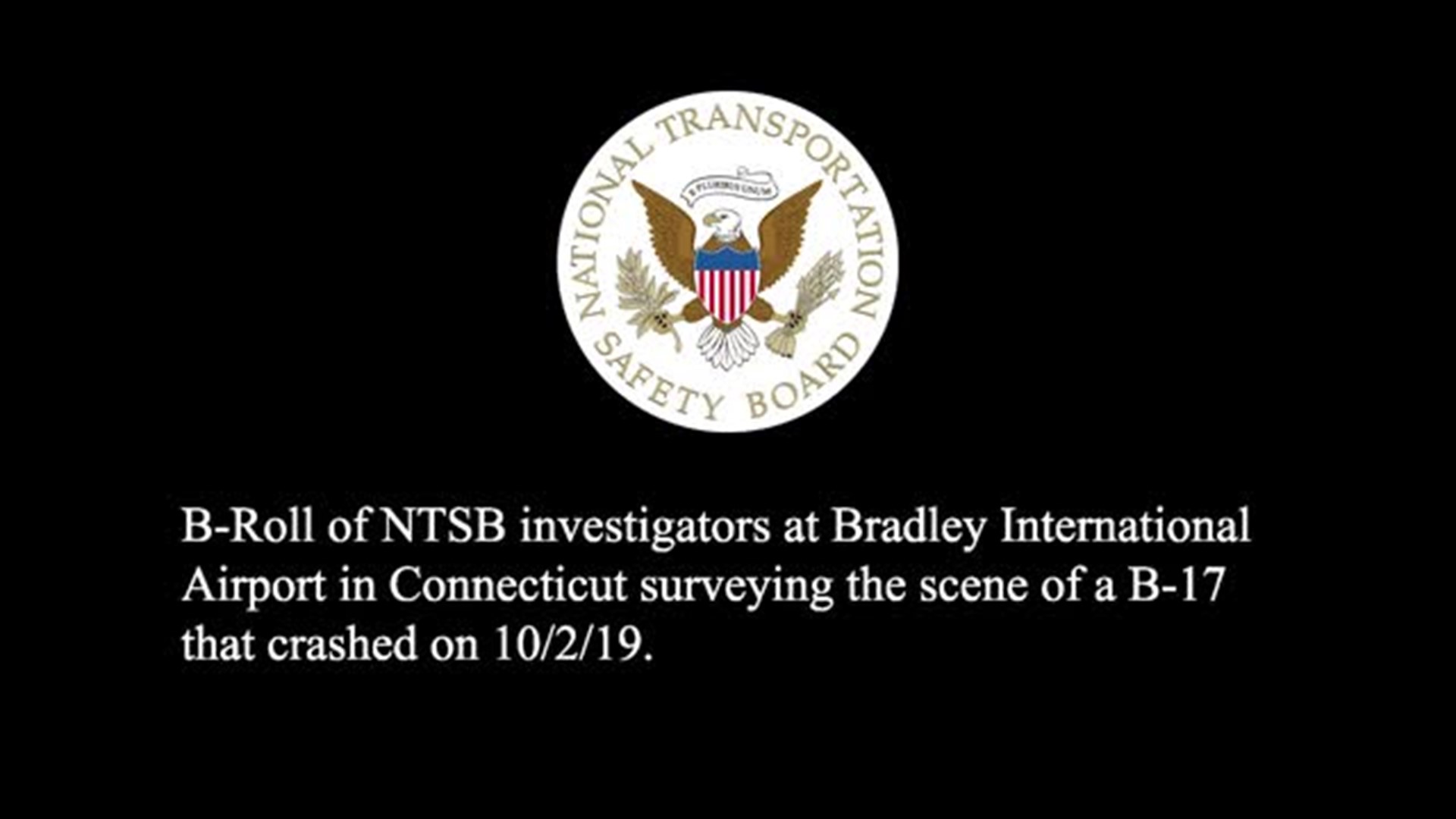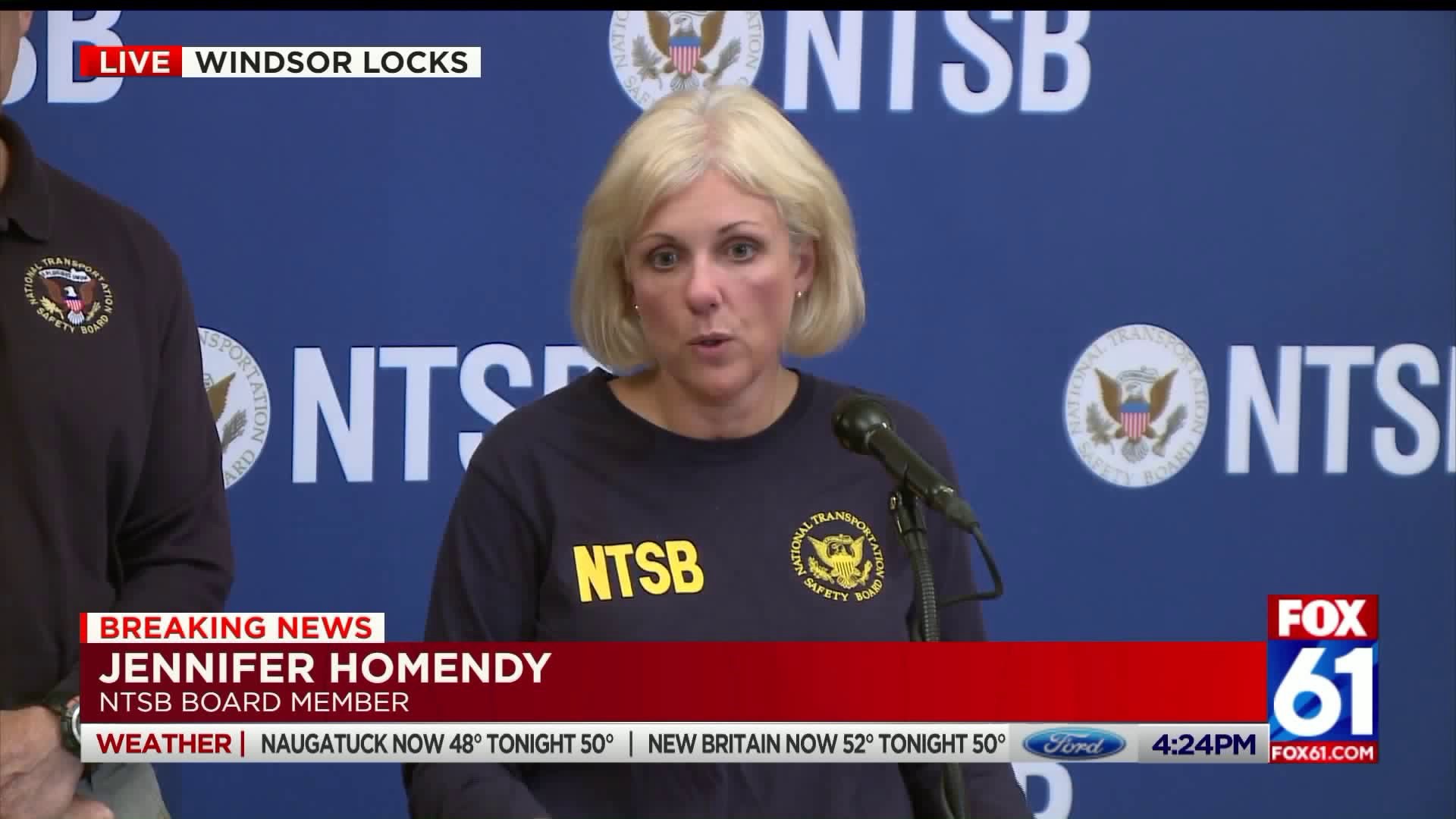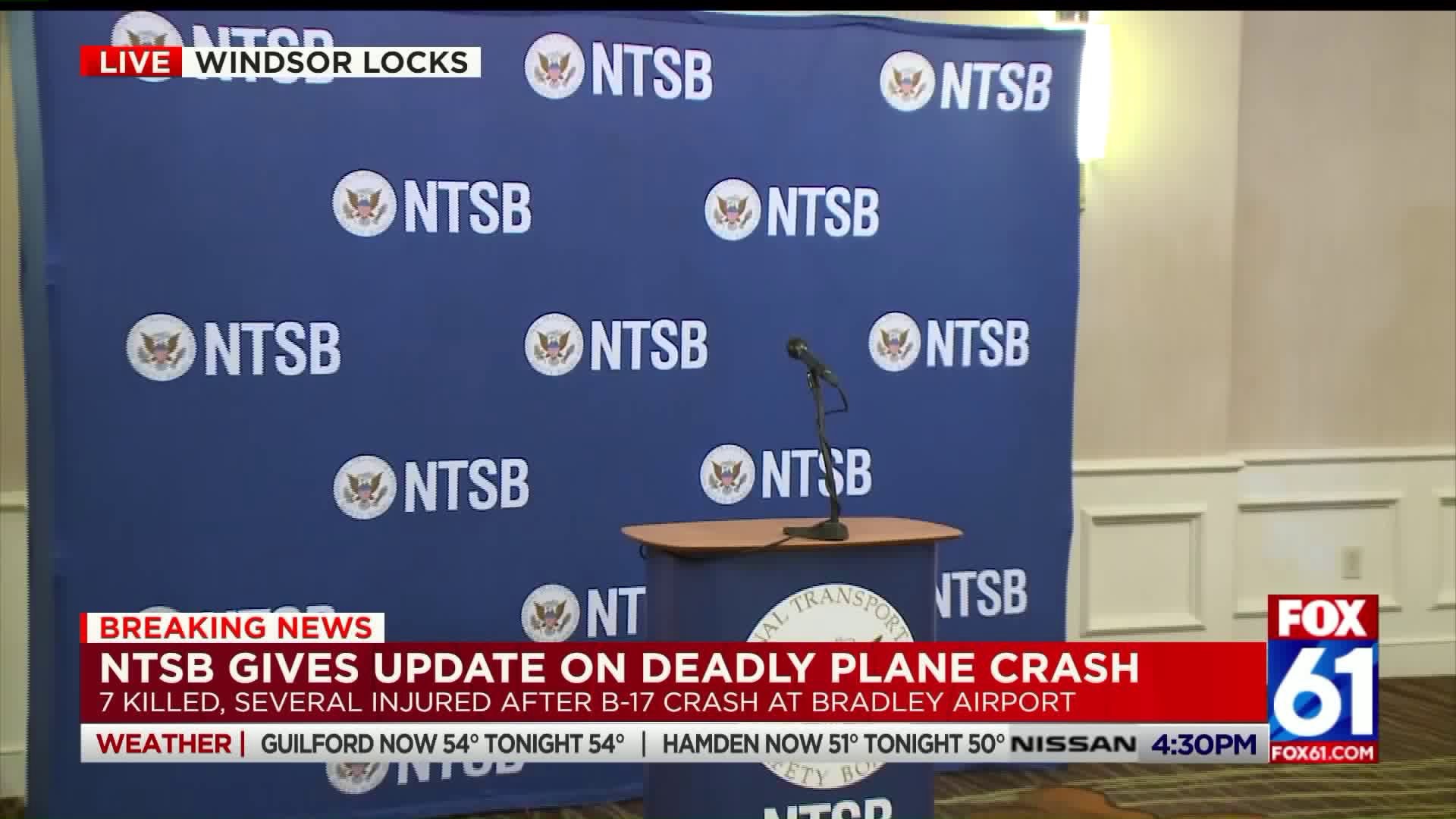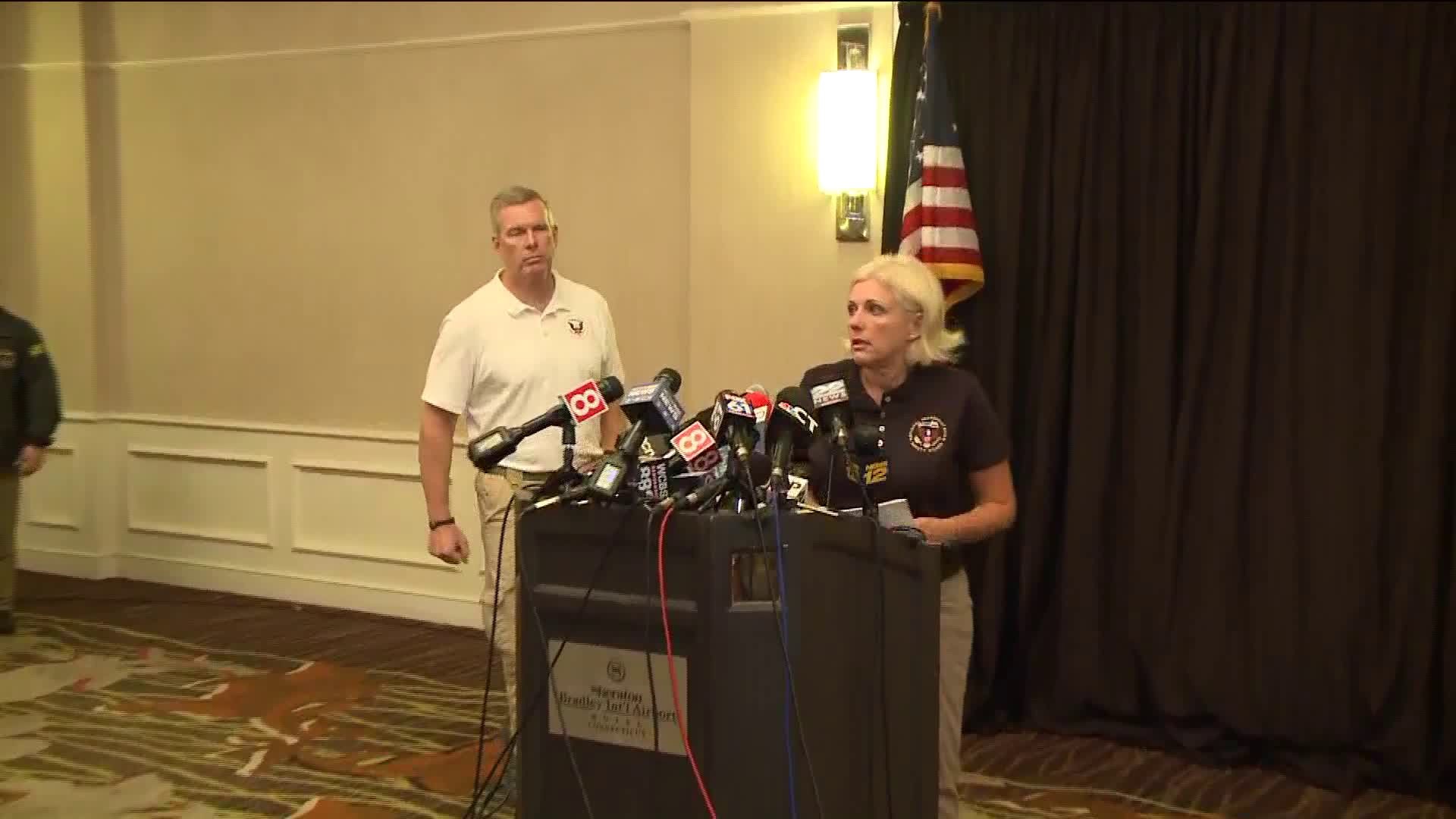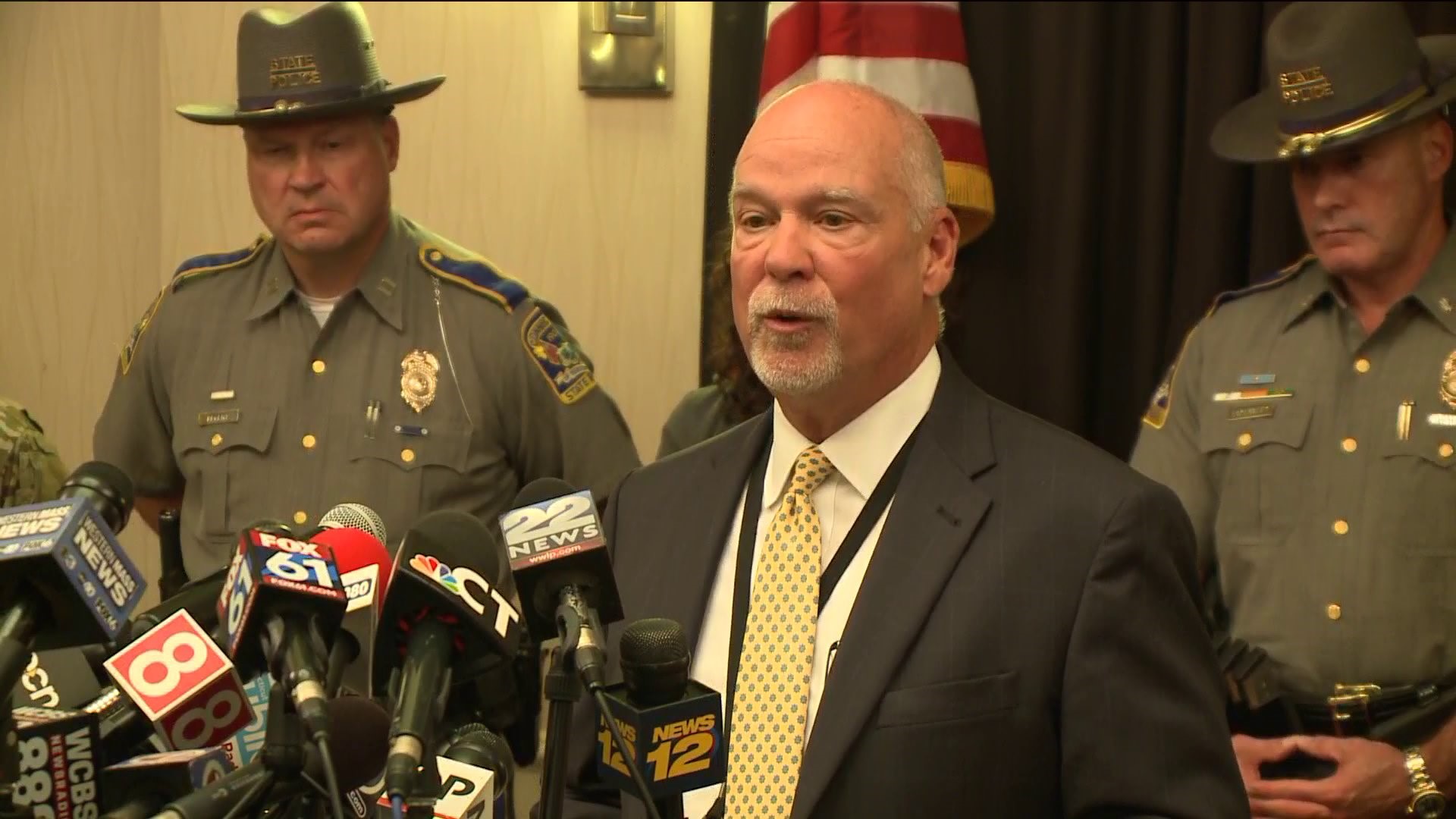WINDSOR LOCKS — State Police have released the names of the victims in Wednesday's crash of a B-17 at Bradley International.
Dead or presumed dead are Ernest 'Mac' McCauley, 75, pilot; Michael Foster, 71, Co-pilot; David Broderick 56, of West Springfield, passenger, Gary Mazzone, 66, of Broad Brook, passenger; James Roberts, 48, of Ludlow, Mass., passenger; Robert Riddell, 59, East Granby, passenger; Robert Rubner, 64, of Tolland, passenger.
Injured in the crash were Metlon Mitchell, 34, of Dalehart TX, flight engineer; Andy Barrett, 36, of South Hadley, passenger; Linda Schmidt, 62, of Suffield, passenger; Tom Schmidt, 62, of Suffield, passenger; Joseph Huber, 48, of Tarriffville, passenger; Andrew Sullivan, 28, of Enfield, airport personnel; James Trafficante, 54, Simsbury, passenger.
NTSB holds press conference Thursday afternoon:
In a statement the National Guard described what happened:
The Airman is the current command chief for the 103rd Airlift Wing and a trained C-130 loadmaster. As an aircrew member, he has training and experience in handling emergency incidents on aircraft. He brought his military issued flame retardant flight gloves with him during the flight, and using these, was able to open a hatch on the aircraft allowing other passengers to egress the plane after the crash. He suffered injuries and was transported to Hartford Hospital for treatment. He was released yesterday evening and continues to recover at home. Any further details on his specific actions will be revealed through the investigation.
The member of the Guard has not been identified.
The FAA said, "It’s still too early in the investigation to determine what happened in the accident. If we discover an issue that might apply to the fleet as a whole, we will take the appropriate action based on the evidence."
Eric Whyte identified the pilot as his friend Mac McCauley.
"As some of you know I am very lucky to be one of the Collings Foundation Wings of Freedom Tour Pilots. Today we suffered a terrible tragedy and lost several amazing people. The pilot community is a close knit group but an organization like this is even tighter.
A former Vernon police officer has been identified as one of the victims of the B-17 crash at Bradley International Airport Wednesday.
The World War II-era plane with 13 people aboard crashed and burned at the Hartford airport after encountering mechanical trouble on takeoff Wednesday, killing seven people.
Authorities have not officially identified any of the victims in the crash.
Vernon police said retired Captain Gary Mazzone was killed in the crash. He served as a Vernon officer from 1976 to 1998. HE went on to work at the Division of Criminal Justice and retired there in January. Lt. William Meier said in a statement, "Captain Mazzone spent over 42 years in law enforcement serving the town and the state. He had a special relationship with Special Olympics Connecticut and is a member of their hall of fame. As recent as last month, he was still supporting VPD's efforts with Special Olympics."
A woman who said her husband was on the plane at the time posted a letter on Facebook.
Debra Riddell wrote:
It’s been a long and tragic day. Words cannot express how devastated I am. At this point, all survivors have been identified. Rob was not one of them. We are waiting for the M.E. To identify those who did not make it. Your thoughts and prayers are greatly appreciated.
Rob was the best person I’ve ever known. He was my soul mate I will miss him beyond words can ever express. He loved his children more than anyone could know and the new grandson was the apple of his eye. He embraced my daughter and grandchildren and loved them as his own.
He was brilliant, loving, funny, reliable, compassionate and the best man I’ve ever known. The world lost an amazing person today.
My heart goes out to the other people that lost loved ones but especially the people who survived this crash.
Thank you for your support and love.
The four-engine, propeller-driven B-17 bomber struggled to get into the air and slammed into a maintenance building at Bradley International Airport as the pilots circled back for a landing, officials and witnesses said.
Connecticut Public Safety Commissioner James Rovella said hours after the crash that some of those on board were burned, and “the victims are very difficult to identify.”
Some of the survivors of the crash were critically injured, authorities said. One person on the ground was also hurt in the crash and a firefighter involved in the response suffered a minor injury. No children were on the plane.
The death toll of seven could rise, Rovella said. He said some lives were likely saved by the efforts of people including a person who raced to help the victims and people on the plane who helped others to escape the fire by opening a hatch, Rovella said.
“You’re going to hear about some heroic efforts from some of the individuals that were in and around that plane,” he said.
The retired, civilian-registered plane was associated with the Collings Foundation, an educational group that brought its Wings of Freedom vintage aircraft display to the airport this week, officials said.
"I believe he's probably the highest B-17 Pilot out there," said Prescott. "In addition to being an airline pilot, he was a very very well trained pilot with a very high degree of safety training on a regular basis."
The vintage bomber _ also known as a Flying Fortress, one of the most celebrated Allied planes of World War II _ was used to take history buffs and aircraft enthusiasts on short flights, during which they could get up and walk around the loud and windy interior.
“Right now my heart really goes out to the families who are waiting,” Gov. Ned Lamont said. “And we are going to give them the best information we can as soon as we can in an honest way.”
The National Transportation Safety Board sent a team of 10 to investigate the cause of the crash.
The plane was a few minutes into the flight when the pilots reported a problem and said it was not gaining altitude, officials said. It lost control upon touching down and struck a shed at a de-icing facility just before 10 a.m.
FOX61's Carmen Chau spoke to David Prescott - a retired Collings Foundation Pilot who knows the pilot that was in the crash, where he commended his years of experience.
The airport, New England’s second-busiest, was closed afterward but reopened a single runway about 3½ hours later.
Flight records from FlightAware shows the plane had traveled about 8 miles (13 kilometers) and reached an altitude of 800 feet (244 meters).
In recordings of audio transmissions, the pilot told an air traffic controller that he needed to return to the airport and land immediately. Asked why, he said: “Number four engine, we’d like to return and blow it out.”
Listen to the radio transmissions as the pilot of the B-17 requests to return to the airport and report a problem with engine #4. Courtesy LiveATC.net.
Brian Hamer, of Norton, Massachusetts, said he was less than a mile away when he saw a B-17, “which you don’t normally see,” fly directly overhead, apparently trying without success to gain altitude.
One of the engines began to sputter, and smoke came out the back, Hamer said. The plane made a wide turn and headed back toward the airport, he said.
“Then we heard all the rumbling and the thunder, and all the smoke comes up, and we kind of figured it wasn’t good,” Hamer said.
Antonio Arreguin, who had parked at a construction site near the airport, said he did not see the plane but heard the explosion and could feel the heat from “this big ball of orange fire” about 250 yards (229 meters) away.

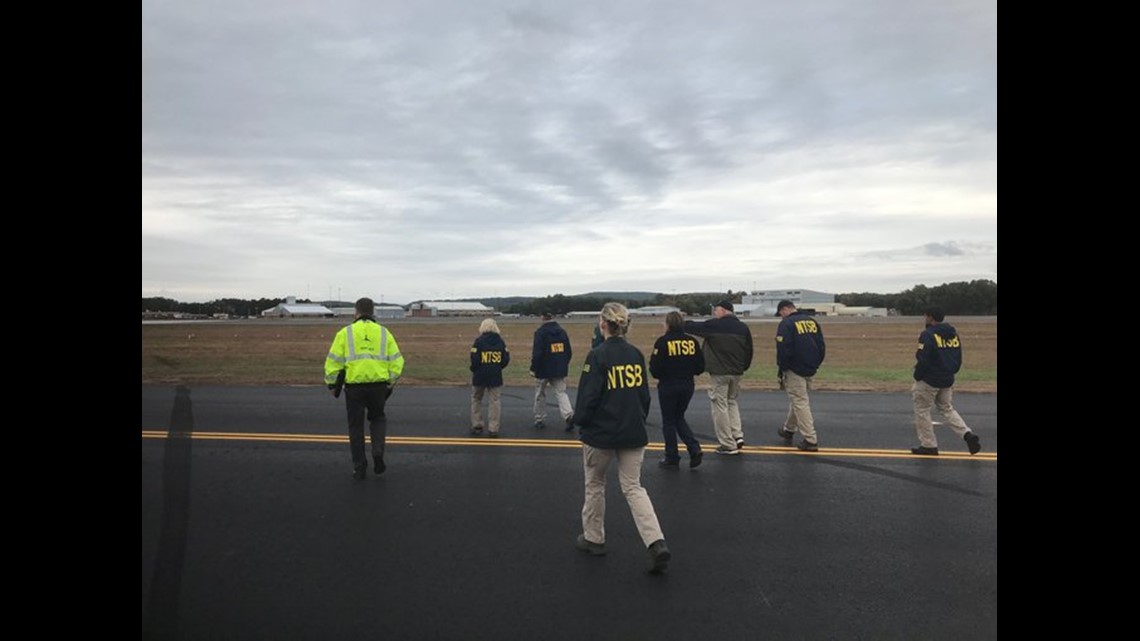
The same plane also crashed in 1987 at an air show near Pittsburgh, injuring several people, the Collings Foundation said. Hit by a severe crosswind as it touched down, the bomber overshot a runway and plunged down a hill. It was later repaired.
The crash reduces to nine the number of B-17s actively flying, said Rob Bardua, spokesman for the National Museum of the U.S. Air Force, near Dayton, Ohio.
Boeing-built B-17 Flying Fortresses _ 74 feet (23 meters) long, with a wingspan of 104 feet (32 meters) _ were used in daylight bombing raids against Germany during the war. The missions were extremely risky, with high casualty rates, but helped break the Nazis’ industrial war machine.
The B-17 that went down was built in 1945, too late to see combat in the war, according to the Collings Foundation.
It served in a rescue squadron and a military air transport service before being subjected to the effects of three nuclear explosions during testing, the foundation said. It was later sold as scrap and eventually was restored. The foundation bought it in 1986.

